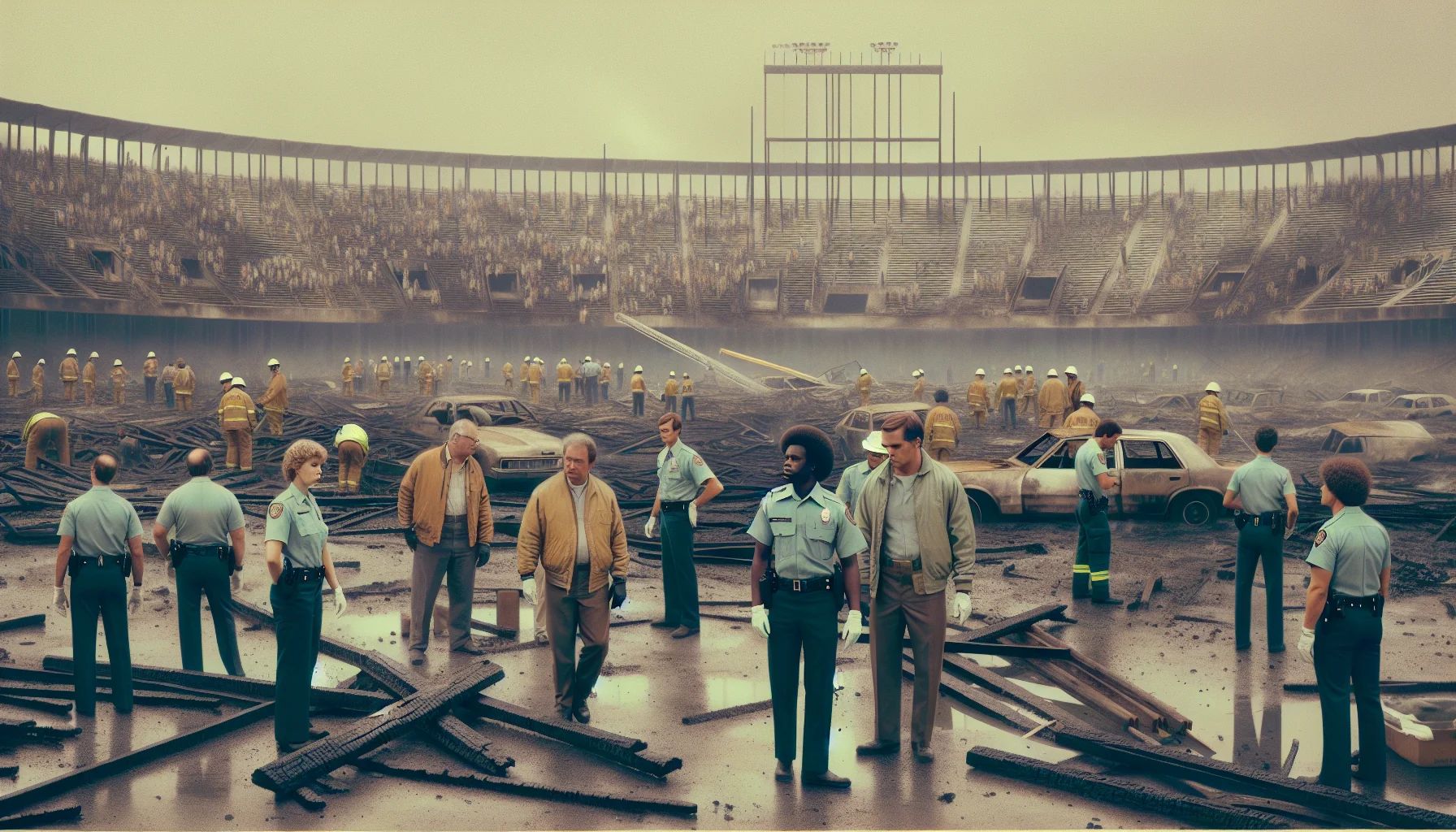
The Bradford City Stadium Fire
by: The Calamity Calendar Team
May 11, 1985
A Season of Triumph Turns to Tragedy
May 11, 1985, was supposed to be a day of celebration for Bradford City A.F.C. The club had just secured the Third Division championship, marking a significant victory in its storied history. Valley Parade was buzzing with anticipation, where fans, young and old, gathered for what should have been a joyous occasion. The vibrant atmosphere was palpable as the crowd of over 11,000 filled the stands to witness their team play against Lincoln City. But beneath the festivities loomed a shadow—a hidden danger that would soon turn triumph into tragedy.
The wooden main stand, a relic from 1908, was steeped in history but fraught with peril. Safety concerns were whispered about but largely overlooked amidst the exhilaration of the season's close. Underneath the seats, litter had accumulated over the years, a quietly ticking time bomb of debris waiting for a spark. A modern fire certificate was conspicuously absent, and the stand’s aged wood offered little resistance to the inevitable.
The Day of Celebration Begins
As the clock struck 3:40 PM, the match kicked off amid cheers and roars from the fans. The sunlit pitch glowed beneath the clear skies, setting the stage for a memorable day. Yet, just four minutes in, a wisp of smoke slid from under the roof of the main stand, a harbinger of the chaos to come. At first, it seemed an inconvenience, something to be inspected post-match, certainly nothing to disrupt the proceedings. Those who noticed brushed it off as quickly as it appeared, oblivious to the disaster it foretold.
In mere moments, the smoke intensified as the fire took hold, transforming the celebration into a nightmare. The timber and debris combusted, feeding the flames that swept through the stand with a terrifying swiftness. By 3:55 PM, the fiery beast was uncontrollable, driven by the wind and the stand’s antiquated architecture. Fans caught in its path were forced to make split-second decisions—flee for their lives or risk being consumed by the blaze.
A Struggle to Escape
The referee blew his whistle, halting the game as the inferno roared behind the players. Panic gripped the crowd as they scrambled for exits. Unfortunately, the narrow gates and jammed turnstiles proved poor allies to those in desperate need. Chaos reigned, with people climbing over others, some leaping from the stand to escape. The stands, once alive with cheers, were now the scene of a desperate bid for survival.
As 4:00 PM arrived, so did the emergency services, met with a pandemonium that could scarcely be contained. The priority was clear: evacuate as many as possible from the deadly jaws of the fire. First responders worked frantically, heroes amidst horror, battling not just the flames but the very structure of the stadium’s outdated design.
Thanks for subscribing!
Scars That Time Cannot Heal
It was 4:30 PM when the fire was finally subdued. Yet, the victory over the flames was hollow; the damage was already done. Fifty-six souls were lost to the fire that day, each a name, a face, a story that left a tremendous void in the lives of their families and the community. Another 265 were injured, their physical scars a lingering testament to the disaster they endured.
The aftermath was a scene of devastation, with the charred remains of the wooden stand casting a dark shadow over the ground where jubilance had so recently thrived. For Bradford City A.F.C., the road to recovery was long and fraught with emotional and financial challenges.
Lessons in Loss
The fire's aftermath brought more than grief; it sparked a determination to ensure such a catastrophe could never occur again. The Popplewell Inquiry, led by Sir Oliver Popplewell, dissected the disaster, resulting in recommendations that reshaped the safety protocols within sports venues across the UK. Wooden stands were condemned, and a new era of fire safety standards was ushered in, demanding stricter regulations and modernized facilities.
The reforms were a testament to the resilience and dedication to safety borne from tragedy, encapsulated in the changes to stadium architecture and emergency procedures that followed. The improvements reflected a collective promise to protect future generations from the familial and communal heartbreak suffered on that fateful day.
Remembering and Rebuilding
The lessons learned from the Bradford City stadium fire reverberate still, echoing in the modern designs and stringent safety checks of today’s stadiums. Memorials stand as poignant reminders of the lives lost, urging us to remember and honor their stories while reminding us of our responsibility to safety and vigilance.
Conversations continue, ensuring this chapter in football history is not forgotten, but rather serves as the enduring foundation of safety upon which future sojourns into sport are built. Each new stadium, each updated policy is part of a living legacy—a promise kept to those 56 who never returned from a day of celebration turned tragic.
Stay in the Loop!
Become a Calamity Insider and get exclusive Calamity Calendar updates delivered straight to your inbox.
Thanks! You're now subscribed.